Influence Mechanism of Cu Layer Thickness on Photoelectric Properties of IWO/Cu/IWO Films
Abstract
:1. Introduction
2. Materials and Methods
3. Results and Discussion
3.1. Morphology and Structure
3.2. Optical Properties
3.3. Electrical Properties
4. Conclusions
Author Contributions
Funding
Conflicts of Interest
References
- Nomura, K.; Ohta, H.; Ueda, K.; Kamiya, T.; Hirano, M.; Hosono, H. Thin-film transistor fabricated in single-crystalline transparent oxide semiconductor. Science 2003, 300, 1269–1272. [Google Scholar] [CrossRef] [PubMed]
- Zhang, K.H.L.; Egdell, R.G.; Offi, F.; Iacobucci, S.; Petaccia, L.; Gorovikov, S.; King, P.D.C. Microscopic origin of electron accumulation in In2O3. Phys. Rev. Lett. 2013, 110, 056803. [Google Scholar] [CrossRef] [PubMed] [Green Version]
- Lu, X.; Chen, A.; Luo, Y.; Lu, P.; Dai, Y.; Enriquez, E.; Dowden, P.; Xu, H.; Kotula, P.G.; Azad, A.K.; et al. Conducting interface in oxide homojunction: understanding of superior properties in black TiO2. Nano Lett. 2016, 16, 5751–5755. [Google Scholar] [CrossRef] [PubMed] [Green Version]
- Parthiban, S.; Gokulakrishnan, V.; Elangovan, E.; Goncalves, G.; Ramamurthi, K.; Fortunato, E.; Martins, R. High mobility and visible-near infrared transparent titanium doped indium oxide thin films produced by spray pyrolysis. Thin Solid Films 2012, 524, 268–271. [Google Scholar] [CrossRef]
- Huang, W.; Zhu, B.; Chang, S.Y.; Zhu, S.; Cheng, P.; Hsieh, Y.T.; Meng, L.; Wang, R.; Wang, C.; Zhu, C.; et al. High mobility indium oxide electron transport layer for an efficient charge extraction and optimized nanomorphology in organic photovoltaics. Nano Lett. 2018, 18, 5805–5811. [Google Scholar] [CrossRef] [PubMed]
- Janotti, A.; Van de Walle, C.G. Fundamentals of zinc oxide as a semiconductor. Rep. Prog. Phys. 2009, 72, 126501. [Google Scholar] [CrossRef] [Green Version]
- Cheng, Y.; Zhang, X.; Che, L.; Chen, J.; Jing, B.; Sun, R.; Luo, X. Binding energy of Sb-related complex in p-doped ZnO film. J. Alloys Compd. 2019, 800, 219–223. [Google Scholar] [CrossRef]
- Kolhe, P.S.; Shinde, A.B.; Kulkarni, S.G.; Maiti, N.; Koinkar, P.M.; Sonawane, K.M. Gas sensing performance of Al doped ZnO thin film for H2S detection. J. Alloys Compd. 2018, 748, 6–11. [Google Scholar] [CrossRef]
- Shivashankar, E.; Elangovan, S.A.; Ramamurthi, K. Studies on structural and electrical properties of sprayed SnO2: Sb films. J. Cryst. Growth 2005, 276, 215–221. [Google Scholar] [CrossRef]
- Huang, Y.; Zhang, Q.; Li, G. Transparent conductive tungsten-doped tin oxide polycrystalline films prepared on quartz substrates. Semicond. Sci. Technol. 2009, 24, 015003. [Google Scholar] [CrossRef]
- Parthiban, S.; Gokulakrishnan, V.; Ramamurthi, K.; Elangovan, E.; Martins, R.; Fortunato, E.; Ganesan, R. High near-infrared transparent molybdenum-doped indium oxide thin films for nanocrystalline silicon solar cell applications. Sol. Energy Mater. Sol. Cells 2009, 93, 92–97. [Google Scholar] [CrossRef]
- Meng, F.; Shi, J.; Liu, Z.; Cui, Y.; Lu, Z.; Feng, Z. High mobility transparent conductive W-doped In2O3 thin films prepared at low substrate temperature and its application to solar cells. Sol. Energy Mater. Sol. Cells 2014, 122, 70–74. [Google Scholar] [CrossRef]
- Lu, X.J.; Mou, X.L.; Wu, J.J.; Zhang, D.W.; Zhang, L.L.; Huang, F.Q.; Xu, F.F.; Huang, S.M. Improved-performance dye-sensitized solar cells using Nb-doped TiO2 electrodes: Efficient electron injection and transfer. Adv. Funct. Mater. 2010, 20, 509–515. [Google Scholar] [CrossRef]
- Kim, M.J.; Kim, H.G.; Kim, S.S. Composite layer formation on plastic substrates for flexible display by using functionalized nanoclay. Macromol. Res. 2012, 20, 739–745. [Google Scholar] [CrossRef]
- Cho, S.-W.; Jeong, J.-A.; Bae, J.-H.; Moon, J.-M.; Choi, K.-H.; Jeong, S.W.; Park, N.-J.; Kim, J.-J.; Lee, S.H.; Kang, J.-W.; et al. Highly flexible, transparent, and low resistance indium zinc oxide-Ag-indium zinc oxide multilayer anode on polyethylene terephthalate substrate for flexible organic light-emitting diodes. Thin Solid Films 2008, 516, 7881–7885. [Google Scholar] [CrossRef]
- Ryu, S.Y.; Jo, S.J.; Kim, C.S.; Choi, S.H.; Noh, J.H.; Baik, H.K.; Jeong, H.S.; Han, D.W.; Song, S.Y.; Lee, K.S. Transparent organic light-emitting diodes using resonant tunneling double barrier structures. Appl. Phys. Lett. 2007, 91, 093515. [Google Scholar] [CrossRef]
- Kumar, N.; Arora, K.; Kumar, M. High performance, flexible and room temperature grown amorphous Ga2O3 solar-blind photodetector with amorphous indium-zinc-oxide transparent conducting electrodes. J. Phys. D Phys. 2019, 5, 335103. [Google Scholar] [CrossRef]
- Faber, H.; Das, S.; Lin, Y.-H.; Pliatsikas, N.; Zhao, K.; Kehagias, T.; Dimitrakopulos, G.; Amassian, A.; Patsalas, P.A.; Anthopoulos, T.D. Heterojunction oxide thin-film transistors with unprecedented electron mobility grown from solution. Sci. Adv. 2017, 3, 1602640. [Google Scholar] [CrossRef] [Green Version]
- Nomura, K.; Ohta, H.; Takagi, A.; Kamiya, T.; Hirano, M.; Hosono, H. Room-temperature fabrication of transparent flexible thin-film transistors using amorphous oxide semiconductors. Nature 2004, 432, 488–492. [Google Scholar] [CrossRef]
- Adamopoulos, G.; Thomas, S.; Wobkenberg, P.H.; Bradley, D.D.C.; McLachlan, M.A.; Anthopoulos, T.D. High-mobility low-voltage ZnO and Li-doped ZnO transistors Based on ZrO2 high-k dielectric grown by spray pyrolysis in ambient air. Adv. Mater. 2011, 23, 1894. [Google Scholar] [CrossRef]
- Zhang, L.; Zhou, Y.; Guo, L.; Zhao, W.; Barnes, A.; Zhang, H.T.; Eaton, C.; Zheng, Y.; Brahlek, M.; Haneef, H.F. Correlated metals as transparent conductors. Nat. Mater. 2016, 15, 204–210. [Google Scholar] [CrossRef] [PubMed]
- Guo, S.; Yang, L.; Dai, B.; Geng, F.; Yang, Z.; Lei, P.; Wang, P.; Gao, G.; Han, J.; Ralchenko, V. Hydrated magnesium-carbon films with conductivity and wide-range visible-to-far-infrared transparency. Mater. Lett. 2018, 216, 88–91. [Google Scholar] [CrossRef]
- Ellmer, K. Past achievements and future challenges in the development of optically transparent electrodes. Nat. Photonics 2012, 6, 809–817. [Google Scholar] [CrossRef]
- Bhosle, V.; Prater, J.T.; Yang, F.; Burk, D.; Forrest, S.R.; Narayan, J. Gallium-doped zinc oxide films as transparent electrodes for organic solar cell applications. J. Appl. Phys. 2007, 102. [Google Scholar] [CrossRef]
- Guillén, C.; Herrero, J. TCO/metal/TCO structures for energy and flexible electronics. Thin Solid Films 2011, 520, 1–17. [Google Scholar] [CrossRef]
- Ryu, S.Y.; Noh, J.H.; Hwang, B.H.; Kim, C.S.; Jo, S.J.; Kim, J.T.; Hwang, H.S.; Baik, H.K.; Jeong, H.S.; Lee, C.H.; et al. Transparent organic light-emitting diodes consisting of a metal oxide multilayer anode. Appl. Phys. Lett. 2008, 92, 15. [Google Scholar] [CrossRef]
- Wu, H.-W.; Yang, R.-Y.; Hsiung, C.-M.; Chu, C.-H. Influence of Ag thickness of aluminum-doped ZnO/Ag/aluminum-doped ZnO thin films. Thin Solid Films 2012, 520, 7147–7152. [Google Scholar] [CrossRef]
- Sahu, D.R.; Lin, S.-Y.; Huang, J.-L. Investigation of conductive and transparent Al-doped ZnO/Ag/Al-doped ZnO multilayer coatings by electron beam evaporation. Thin Solid Films 2008, 516, 4728–4732. [Google Scholar] [CrossRef]
- Crupi, I.; Boscarino, S.; Strano, V.; Mirabella, S.; Simone, F.; Terrasi, A. Optimization of ZnO:Al/Ag/ZnO:Al structures for ultra-thin high-performance transparent conductive electrodes. Thin Solid Films 2012, 520, 4432–4435. [Google Scholar] [CrossRef]
- Hu, J.; Gordon, R.G. Textured aluminum-doped zine oxide thin films from atmospheric pressure chemical-vapor deposition. J. Appl. Phys. 1992, 71, 880–890. [Google Scholar] [CrossRef]
- Mass, J.; Bhattacharya, P.; Katiyar, R.S. Effect of high substrate temperature on Al-doped ZnO thin films grown by pulsed laser deposition. Mater. Sci. Eng. B 2003, 103, 9–15. [Google Scholar] [CrossRef]
- Lozano, O.; Chen, Q.Y.; Wadekar, P.V.; Seo, H.W.; Chinta, P.V.; Chu, L.H.; Tu, L.W.; Lo, I.; Yeh, S.W.; Ho, N.J.; et al. Factors limiting the doping efficiency of transparent conductors: A case study of Nb-doped In2O3 epitaxial thin-films. Sol. Energy Mater. Sol. Cells 2013, 113, 171–178. [Google Scholar] [CrossRef]
- Dong, D.; Wang, W.; Zhang, F.; Fu, Q.; Pan, J. Preparation and characterization of micro-grid modified In2O3: W films. Thin Solid Films 2016, 612, 1–7. [Google Scholar] [CrossRef]
- Günther, C.; Günther, S.; Kopatzki, E. Microscopic Aspects of Thin Metal Film Epitaxial Growth on Metallic Substrates. Ber. Bunsenges. Phys. Chem. 1993, 97, 522–537. [Google Scholar] [CrossRef]
- Zhang, D.; Yabe, H.; Akita, E.; Wang, P.; Murakami, R.; Song, X. Effect of silver evolution on conductivity and transmittance of ZnO/Ag thin films. J. Appl. Phys. 2011, 109, 104318. [Google Scholar] [CrossRef]
- Kreibig, U.; Fragstein, C.V. The Limitation of Electron Mean Free Path in Small Silver Particles. Z. Phys. 1969, 224, 307–323. [Google Scholar] [CrossRef]
- Sakaguchi, K.; Fukazawa, M.; Shimakawa, K.; Hatanaka, Y. Highly conductive titanium oxide films by RF magnetron sputtering. Phys. Status Solidi 2011, 8, 2742–2745. [Google Scholar] [CrossRef]
- Chen, T.C.; Ma, T.P.; Barker, R.C. Properties and applications of infrared transparent and electrically conductive In2O3 thin film. Proc. SPIE 1983, 430, 270. [Google Scholar] [CrossRef]
- Coutts, T.J.; Young, D.L.; Li, X. Characterization of transparent conducting oxides. MRS Bull. 2000, 25, 58–65. [Google Scholar] [CrossRef]
- Adkins, J.C. Conduction in granular metals-variable-range hopping in a Coulomb gap. J. Phys. Condens. Matter 1989, 1, 1253–1259. [Google Scholar] [CrossRef]
- Dhar, A.; Alford, T.L. High quality transparent TiO2/Ag/TiO2 composite electrode films deposited on flexible substrate at room temperature by sputtering. APL Mater. 2013, 1, 012102. [Google Scholar] [CrossRef]
- Lourens, J.A.J.; Arajs, S.; Helbig, H.F.; Mehanna, E.-S.A.; Cheriet, L. Critical behavior of the electrical resistance of very thin Cr films. Phys. Rev. B 1988, 37, 5423–5425. [Google Scholar] [CrossRef] [PubMed]
- Korobov, V.; Leibovitch, M.; Shapira, Y. Structure and conductance evolution of very thin indium oxide films. Appl. Phys. Lett. 1994, 65, 2290–2292. [Google Scholar] [CrossRef] [Green Version]
- Ebisawa, J.; Ando, E. Solar control coating on glass. Curr. Opin. Solid State Mater. 1998, 3, 386–390. [Google Scholar] [CrossRef]
- Sivaramakrishnan, K.; Alford, T.L. Conduction and transmission analysis in gold nanolayers embedded in zinc oxide for flexible electronics. Appl. Phys. Lett. 2010, 96, 201109. [Google Scholar] [CrossRef]

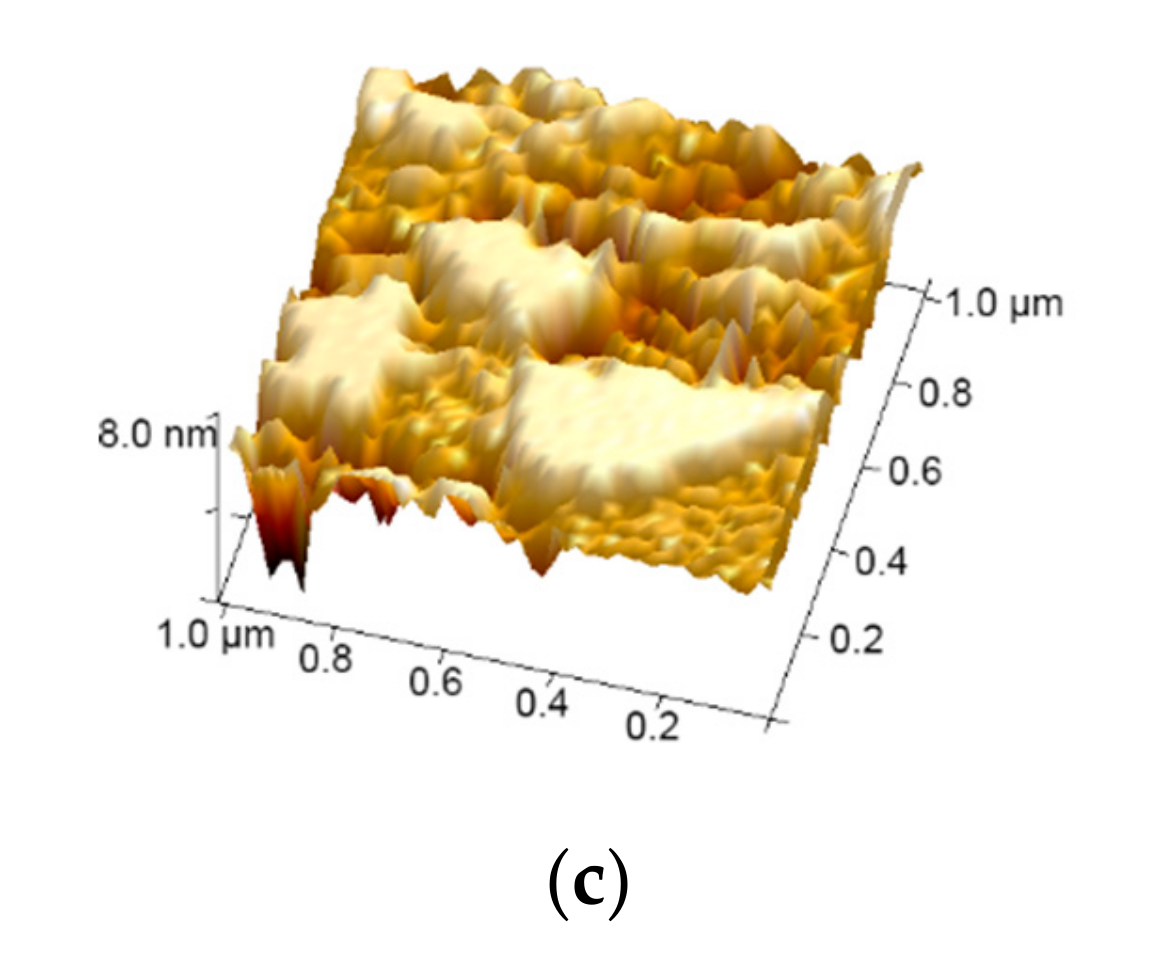
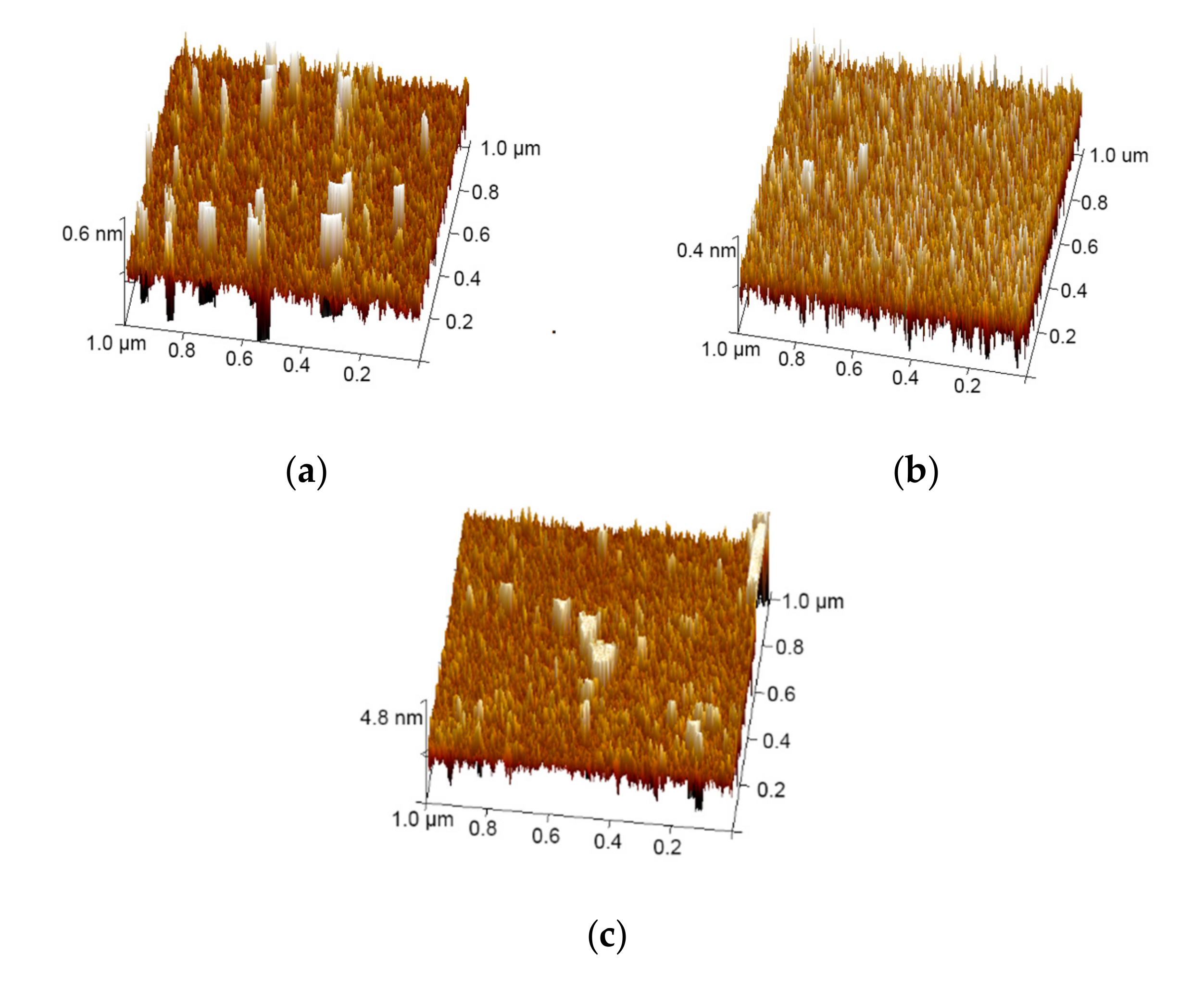
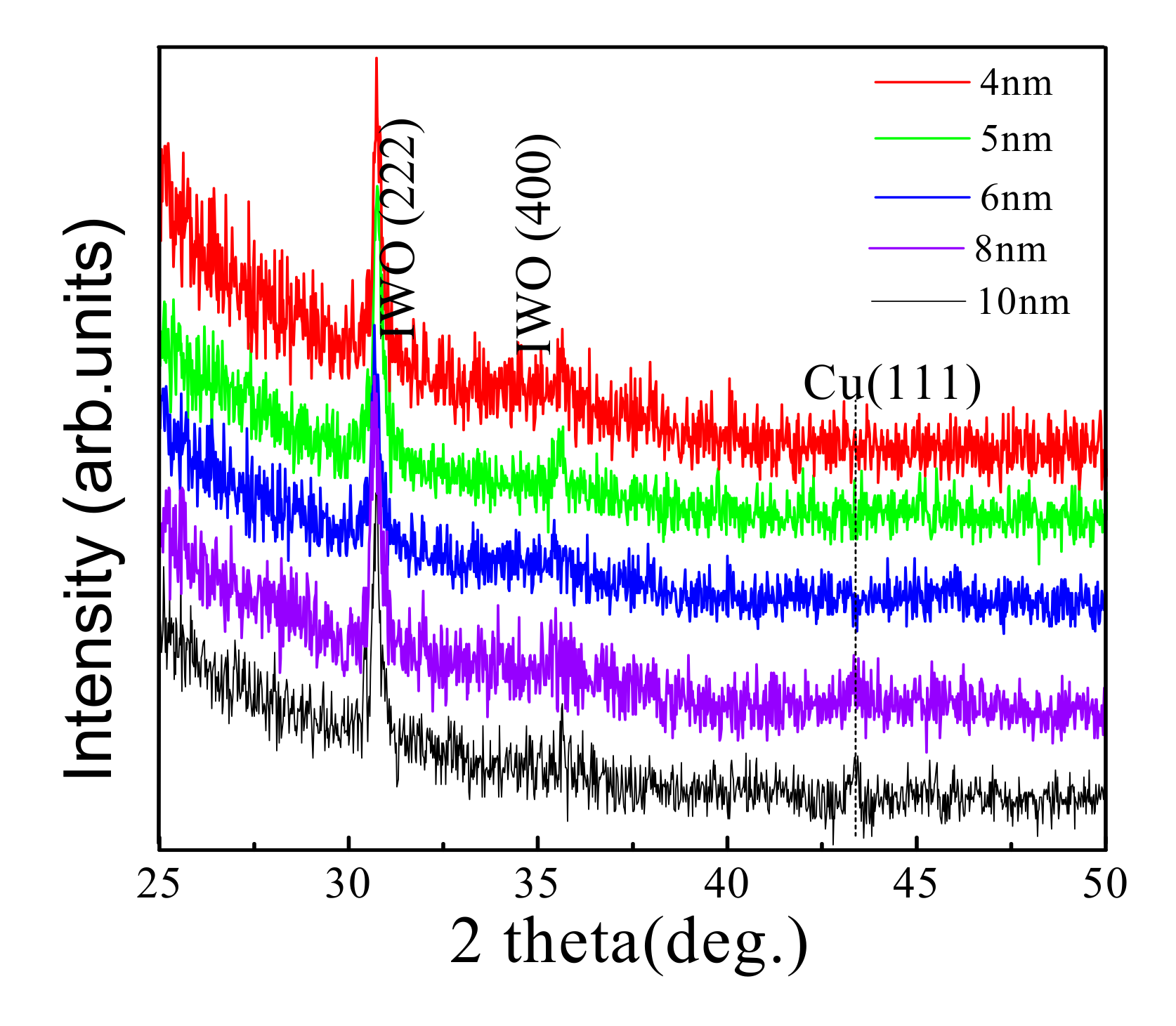

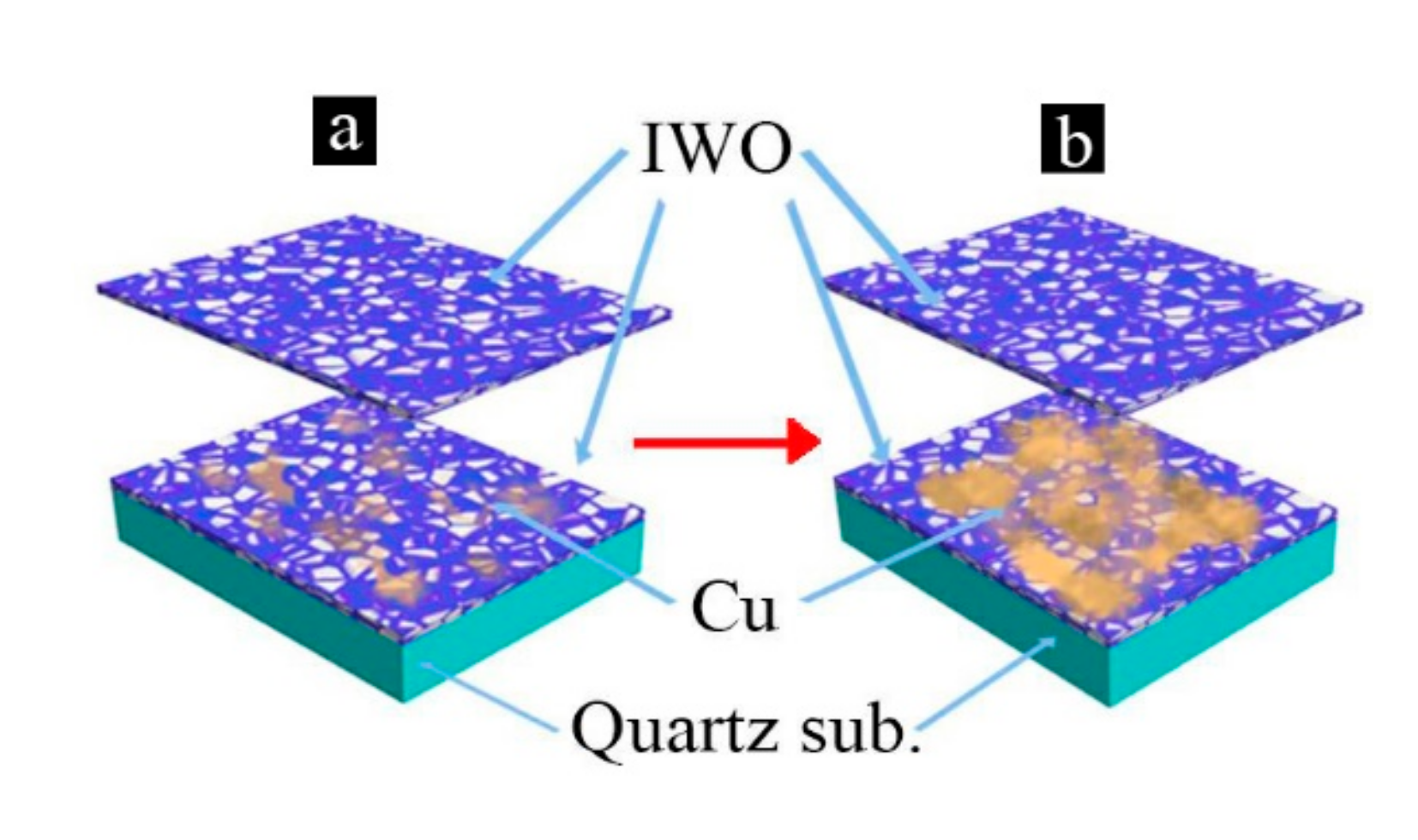
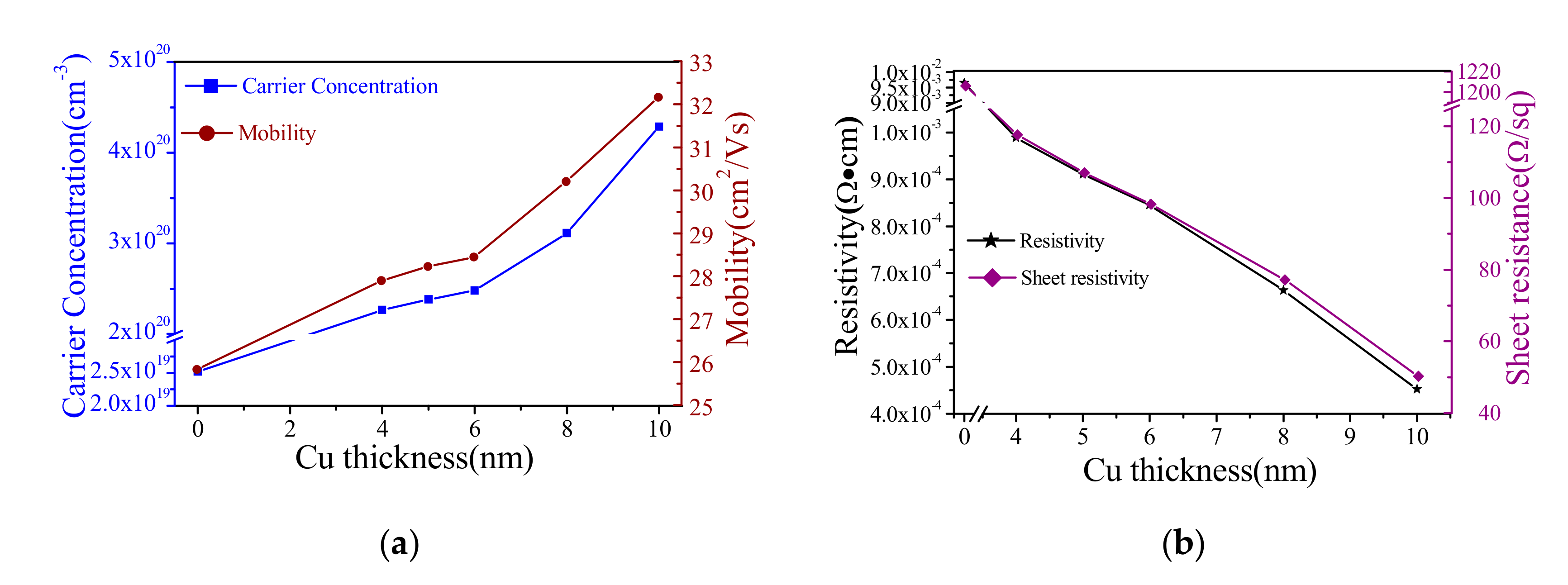
| Layer Type | Ar Flow (sccm) | Power | Growth Time | Growth Rate |
|---|---|---|---|---|
| IWO (upper) | 25 | 35 W | 50 min | 0.8 nm/min |
| Cu | 25 | 50 W | 0, 1, 1.25, 1.5, 2, and 2.5 min | 4 nm/min |
| IWO (bottom) | 25 | 35 W | 50 min | 0.8 nm/min |
© 2019 by the authors. Licensee MDPI, Basel, Switzerland. This article is an open access article distributed under the terms and conditions of the Creative Commons Attribution (CC BY) license (http://creativecommons.org/licenses/by/4.0/).
Share and Cite
Han, F.; Zhao, W.; Bi, R.; Tian, F.; Li, Y.; Zheng, C.; Wang, Y. Influence Mechanism of Cu Layer Thickness on Photoelectric Properties of IWO/Cu/IWO Films. Materials 2020, 13, 113. https://doi.org/10.3390/ma13010113
Han F, Zhao W, Bi R, Tian F, Li Y, Zheng C, Wang Y. Influence Mechanism of Cu Layer Thickness on Photoelectric Properties of IWO/Cu/IWO Films. Materials. 2020; 13(1):113. https://doi.org/10.3390/ma13010113
Chicago/Turabian StyleHan, Fengbo, Wenyuan Zhao, Ran Bi, Feng Tian, Yadan Li, Chuantao Zheng, and Yiding Wang. 2020. "Influence Mechanism of Cu Layer Thickness on Photoelectric Properties of IWO/Cu/IWO Films" Materials 13, no. 1: 113. https://doi.org/10.3390/ma13010113




